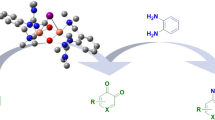Abstract
The NaBH4 reduction of nitrosobenzene to hydrazobenzene/aniline≈3 : 1, phenylhydroxylamine to aniline, azoxybenzene to hydrazobenzene, azobenzene to hydrazobenzene, and hydrazobenzene to aniline is catalysed by bis(dimethylglyoximato)cobalt compounds (“cobaloximes”), CoCl2, and some other salts of transition metals. The NaBH4−CoCl2 system is a convenient and mild reducing agent which effects the reduction of e.g.trans-azobenzene to hydrazobenzene even at −60°C. The diazene configuration has no effect on the reduction of the N=N group;cis-fixed benzo[c]cinnoline is smoothly converted into 2.2′-diaminobiphenyl. Aliphatic diazeneslike 2.3-diazanorbornene andtrans-di-1-adamantyldiazene do not react.
Similar content being viewed by others
Literatur
G. N. Schrauzer, Angew. Chem.88, 465 (1976); s. auch dort zitierte Literatur.
N. G. Gaylord, Reduction with complex metal hydrides. New York: Interscience. 1956.
F. Bohlmann, Chem. Ber.85, 390 (1952).
G. A. Olah, J. Amer. Chem. Soc.81, 3165 (1959).
M. Pesez undJ. F. Burtin, Bull. Soc. Chim. Fr.1949, 1996.
A. A. Vlček undA. Rusina, Proc. Chem. Soc.1961, 161.
T. Neilson, H. C. S. Wood, andA. G. Wylie, J. Chem. Soc.1962, 371.
E. N. Sal'nikova undM. L. Khidelel', Izvest. Akad. Nauk SSSR, Ser. Khim.1967, 223.
T. Satoh undS. Suzuki, Tetrahedron Lett.1969, 4555.
A. E. Brearley, H. Gott, H. A. O. Hill, M. O'Riordan, J. M. Pratt undR. J. P. Williams, J. Chem. Soc.A 1971, 612.
R. A. Egli, Helv. Chim. Acta51, 2090 (1968).
P. Abley, I. Jardine undF. J. McQuillin, J. Chem. Soc.C 1971, 840.
M. I. Bruce, B. L. Goodall, M. Z. Ibqual undF. G. A. Stone, J. Chem. Soc., Chem. Commun.1971, 661.
M. Green undG. Swinden, Inorg. Chim. Acta5, 49 (1971).
G. W. Parshall, J. Amer. Chem.89, 1822 (1967).
A. B. Gilchrist, G. W. rayner-Canham undD. Sutton, Nature235, 42 (1972).
G. N. Schrauzer undR. J. Windgassen, J. Amer. Chem. Soc.89, 1999 (1967).
R. Paul, P. Buisson undN. Joseph, C. R. hebd. Sé. Acad. Sci.232, 627 (1951);
H. I. Schlesinger, H. C. Brown, A. E. Finholt, J. R. Gilbreath, H. R. Hoekstra undE. K. Hyde, J. Amer. Chem. Soc.75, 215 (1953).
H. Stetter undE. Smulders, Chem. Ber.104, 917 (1971).
P. G. Gassman undK. T. Mansfield, Organ Synth.49, 1 (1969).
R. E. Evans, J. Chem. Educ.48, 768 (1971).
Author information
Authors and Affiliations
Rights and permissions
About this article
Cite this article
Avar, G., Kisch, H. Zur katalytischen Reduktion aromatischer Stickstoffverbindungen und Diazene in Gegenwart von Übergangsmetallverbindungen. Monatshefte für Chemie 109, 89–97 (1978). https://doi.org/10.1007/BF00911948
Received:
Issue Date:
DOI: https://doi.org/10.1007/BF00911948




